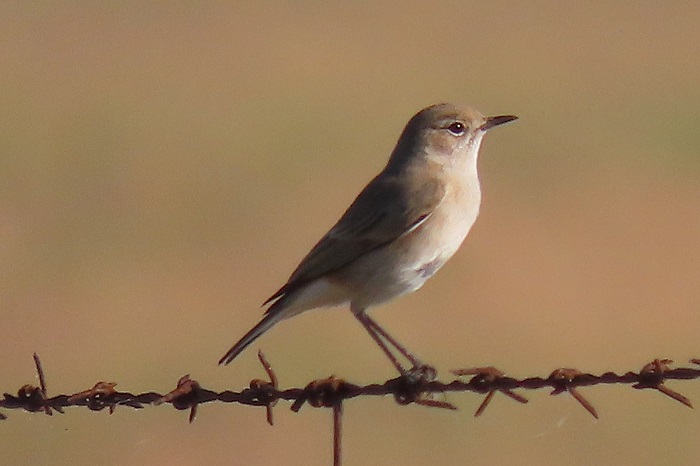Cover image of Sickle-winged Chat by Vaughan Jessnitz – St. Helena Bay, Western Cape – BirdPix No. 152671
Identification
The Sickle-winged Chat is a small, dull coloured species with a pale eye-ring, an upright posture and fairly long legs, giving it a slender appearance.

Carnarvon district, Northern Cape
Photo by Ryan Tippett
The upperparts are greyish-brown which contrast with the pale buffy underparts. The flight feathers have buffy edges. Like other chats, the most distinguishing feature is the colouration and patterning of the rump and tail. In the Sickle-winged Chat the rump and tail are pale pinkish-orange with whitish outer tail feathers, and a broad, black triangular marking on the lower tail. This is diagnostic and most easily observed in flight. The bill, legs and feet are black and the sexes are alike.
Juveniles resemble the adults but are spotted with buff above and have dusky mottling below.

Petrusburg district, Free State
Photo by Rick Nuttall
Most easily mistaken for the Familiar Chat (Oenanthe familiaris) but that species has a darker, rufous-orange rump and an inverted black ‘T-shaped’ marking on the tail.
The Tractrac Chat (Emarginata tractrac) is normally paler but with a similar tail pattern. The Tractrac Chat differs in having a whitish (not pale rufous) rump and tail. Tractrac Chats from the central and upper Karoo in South Africa are browner than in other regions and look very similar to the Sickle-winged Chat. However, the rump and upper tail colours still differ.

Near Virginia, Free State
Photo by Janet du Plooy
The Sickle-winged Chat gets its name from the narrow, tapered tip to the outer primary feather in each wing. This feature is usually only be observed when a bird is held in the hand.

Near Vanrhynsdorp, Western Cape
Photo by Les Underhill
Status and Distribution
The Sickle-winged Chat is a common resident and is endemic to Southern Africa. Its distribution includes most parts of the Nama-Karoo and Succulent Karoo biomes in South Africa and southern Namibia, and extends into the Western Cape and to the grassland biome in the Free State, Lesotho and marginally into KwaZulu-Natal and Mpumalanga.
It is known to undertake some seasonal movements in winter but the patterns are poorly understood. There is no evidence of any changes to its historical range, but the Sickle-winged Chat may have benefitted from agriculture, including from overgrazing. The Sickle-winged Chat is not considered threatened.

Details for map interpretation can be found here.
Habitat

Photo by Ryan Tippett
The Sickle-winged Chat is mainly a bird of flat, open semi-arid Karoo scrub and scrubby, heavily-grazed grasslands. It also inhabits dry fynbos and Renosterbos shrublands in the Western Cape and Alpine grasslands in the Lesotho highlands and adjoining Drakensberg Mountains. It also inhabits cultivated and fallow lands with well-grazed pastures. Seldom associated with human habitation.
The Sickle-winged Chat is most numerous in the grassier, eastern parts of the Karoo followed by Alpine grasslands.

Williston district, Northern Cape
Photo by Ryan Tippett
Behaviour
The Sickle-winged Chat is fairly conspicuous as it frequently perches in exposed positions. It occurs singly, in pairs or less often in family parties. Perches on top of low shrubs, rocks, fences or termite mounds. Flies low from perch to perch and usually flicks its wings just once upon landing.

Carnarvon district, Northern Cape
Photo by Sybrand Venter
May spend several minutes foraging on the ground, running or hopping around quickly on longish legs. Also hunts from a vantage point by dropping onto prey on the ground. The diet consists of a wide range of arthropods like spiders, solifuges, millipedes, centipedes, grasshoppers, termites, ants, flies, moths, butterflies, beetles, caterpillars and small fruits.

Near Dewetsdorp, Free State
Photo by Dawie de Swardt
The Sickle-winged Chat is known to have a spring to summer breeding season. It is a monogamous, solitary nester and is probably territorial. The nest is a cup made of soft, dry grass, fluffy seeds and other soft plant material. It is commonly placed in a depression in the soil at the base of a grass tuft, shrub or stone.
Lays 2 to 4 pale to deep greenish blue eggs, with indistinct pale reddish streaks or speckles. Very few details are known regarding incubation and fledging in this species. The young are known to be fed by both parents.

Biesiesvlei, Free State
Photo by Lance Robinson
Further Resources
Species text adapted from the first Southern African Bird Atlas Project (SABAP1), 1997.
The use of photographs by Dawie de Swardt, Janet du Plooy, Jon Blanco, Lance Robinson, Rick Nuttall, Sybrand Venter and Vaughan Jessnitz is acknowledged.
Virtual Museum (BirdPix > Search VM > By Scientific or Common Name).
Other common names: Vlaktespekvreter (Afrikaans); Traquet aile-en-faux (French); Oranjeschmätzer (German); Vlakte-spekvreter (Dutch); Chasco-asa-de-foice (Portuguese)
Recommended citation format: Tippett RM 2023. Sickle-winged Chat Emarginata sinuata. Biodiversity and Development Institute. Available online at http://thebdi.org/2023/06/05/sickle-winged-chat-emarginata-sinuata/
List of bird species in this format is available here.

Karoo-Gariep Nature Reserve, Northern Cape
Photo by Jon Blanco

